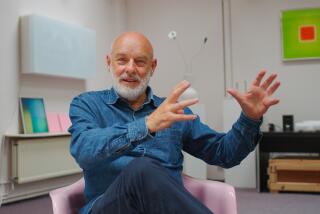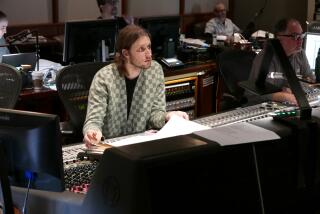Genetic Bolero Intones His Theory of Life : Duarte Research Institute Discovers It Has a Scientist of Some Note
- Share via
Sitting in his cluttered office at the City of Hope’s Beckman Research Institute in Duarte, Susumu Ohno puffed on his pipe and contemplated the origins of life as a soothing piano piece wafted from a tape player, mixing with the aromatic smoke from his tobacco.
Drifting out his office door, the melody possessed a vaguely familiar quality, reminiscent of Peter I. Tchaikovsky. But as Ohno explained to a visitor, the composition was the product of a entirely different kind of culture.
“This is a slime mold,” he said.
Indeed, everything from slime mold to protozoans to the lenses of chicken eyes is literally music to Ohno’s ears. In trying to determine how the first genes were formed, the scientist hit upon the idea of transcribing the chemical formulas for various genes into musical scores.
The resulting pieces, which Ohno has had recorded by a pianist and violinist, resemble a wide variety of classical music styles, from baroque to 20th Century; the more complex the genetic structure, the more contemporary the music sounds.
“This is the very primitive gene of a protozoan, so it’s a little like (Johann Sebastian) Bach; this is a slime mold, so it’s a little more complex, more like Tchaikovsky or around that time,” Ohno said, pausing to pop a cassette labeled “chicken lens” into the tape player on his desk. “This is more like Claude Debussy, don’t you think?”
Novel Brand of Research
Ohno, 59, began turning genes into music about two years ago. He said his novel brand of research is merely a more pleasant way for him to study the origin of life, the question he has probed since he came to the City of Hope in 1953 after receiving his doctorate from the University of Hokkaido in Japan.
About the time he arrived, scientists at the University of Chicago performed a famous experiment to demonstrate how life may have begun on Earth. Electrical charges were sent through a mixture of water, ammonia and methane that simulated the recipe of the “primordial soup” that made up the atmosphere of the newborn planet.
Within weeks, the process resulted in the formation of basic materials such as nucleic acids, the “building blocks” from which life is constructed.
Ohno then set upon the task of discovering how nucleic acids arranged themselves into the complex chemical patterns that permit living organisms to reproduce and evolve.
Although Charles Darwin’s theory of natural selection helped explain why certain genes imbued organisms with traits that enabled them to survive and reproduce, it did not answer the question of why nucleic acids combined in a certain way to create those genes.
‘No Time for Selection’
“In the beginning of life, there was no time for natural selection,” Ohno said. “They were all born because of natural law, not natural selection.”
Comparing the genetic formulas of primeval protozoans to those of multicellular organisms such as fungi, animals and humans, Ohno arrived at the law that he believes governs the formation of genes, the theory of “repetitive recurrence.”
On the surface, genes may appear to be composed of seemingly random assortments of the four nucleic acids--adenine, guanine, thymine and cytosine. But under close examination, the nucleic acids were found to recur periodically in the same order, sometimes in lengthy chains, other times in smaller combinations of links.
“It’s like the way you decipher a cryptogram,” Ohno said. “You look for the repeating units. . . . I think the first genes were all repeats of smaller units.”
To crack these genetic codes, Ohno had to spend endless hours poring over chemical formulas, seeking a recurring pattern among the symbols, A, G, T and C, which represent the four nucleic acids.
In an effort to make his search a bit less tedious, Ohno decided one day to study with his ears instead of his eyes. A devotee of classical music, Ohno theorized that a lengthy sequence of nucleic acids occurring in the same order is much like a series of musical notes similarly arranged.
Develops Harmonic Theory
Because a classical composition typically consists of a main theme containing a certain sequence of notes, followed by a series of melodies based on that theme, Ohno concluded that one could “hear” the genes as a veritable symphony of nucleic acids sounding in a harmonic order.
Ohno’s system for transcribing chemical formulas into musical movements is deceptively simple: Because there are eight notes in an octave scale, he assigned two consecutive notes to each of the four nucleic acids. For example, adenine would be represented by a D or E.
Such a rule allows Ohno great latitude in his efforts to turn nucleic acids into nocturnes. A series of nucleic acids provides him with a selection of notes with which to work, and he takes some liberties in determining the key, time signature and duration of notes for his chemical compositions.
The trick, he said, is to write a piece that faithfully represents the pattern of nucleic acids while satisfying a human need to hear a recognizable melody. Usually, only one arrangement of notes meets both demands, Ohno said.
“Most sound combinations are disharmonious,” he said. “There has to be a melody that is pleasing because it is a repeating unit. Otherwise, it’s just gibberish.”
Echo of Classical
The resulting compositions often bear uncanny resemblances to famous classical pieces. For instance, passages from the transcription of a mouse’s ribonucleic acid, a chromosomal courier of genetic information, sound remarkably like Frederic Chopin’s “Nocturne No. 1,” Ohno said.
In an article in the scientific journal Immunogenetics, Ohno wrote that most who listened to the mouse RNA “readily identified Chopin as its composer.”
The genes-to-music translation also works in reverse, Ohno said, with musical patterns bearing more than a passing resemblance to the nucleic acids of certain genes. When Ohno transcribed a dirge by Chopin into chemical notation, he said that sections of the formula were dead ringers for that of a human cancer gene.
Ohno does not believe that the similarity between genes and music is purely coincidental. He believes that natural law governs the structure of everything from the greatest galaxies to the smallest molecules, including the patterns of human expression.
“Although we might regard musical compositions as the most abstract and therefore probably the most intellectual form of human artistic endeavor, melodies are clearly not human inventions,” Ohno wrote in Immunogenetics.
Pleasant Sound Universal
“The songs of skylarks, canaries and certain other songbirds are as pleasing to our ears as they must be to themselves, as well as to their prospective mates.”
According to Ohno, genes and classical music developed along similar lines and evolved in a systematic progression from simple, orderly patterns to increasingly chaotic ones.
Both protozoans and baroque music are marked by simple patterns, repeated at short and regular intervals, he said. Over long periods of time, the intervals in genes and music become elongated and the patterns become less readily discernible.
Hence, the primitive genes of one-celled organisms evolved into the more complex and specialized genes of plants and animals, Ohno said. Likewise, the simple melodies of baroque music eventually evolved into the experiments with atonal music undertaken by 20th-Century composers, he said.
Although Ohno’s theory is not directly applicable to the immunological research with which the City of Hope is involved, he sees it as a potential key to a puzzle that has intrigued scientists and philosophers for centuries.
“Essentially, I was looking for a universal principle that applied not only to the physical world, but to our mental processes,” Ohno said.
Work Recognized
Ohno’s work in genetics has earned him the title of Distinguished Scientist at the Beckman Research Institute and accolades from the scientific community, such as the Emory Prize from the American Academy of Arts and Sciences in 1981. Ohno has presented his theories--and his music--at scientific conferences all over the world.
However, not all scientists are in harmonious agreement with Ohno’s use of music to support his theory that a pervasive natural law governs everything from RNA to Wolfgang Amadeus Mozart.
“It’s cute, but I don’t think it’s profound,” said Leroy E. Hood, chairman of the biology department at Caltech in Pasadena.






